First aid for head and spinal cord injuries
Posted by Specialist Doctor I Trinh Ngoc Duy - Emergency Doctor - Emergency Department - Vinmec Times City International Hospital
Head, neck and spinal cord injuries are serious injuries and can have dangerous complications that cause nerve damage and breathing problems. Therefore, timely first aid for head and spinal cord injuries is extremely important.
1. Overview
Injuries to the head, neck, and spinal cord are very dangerous because they can cause loss of movement (paralysis), coma and death. Trauma to the spinal cord causes nerve damage and makes breathing difficult.

Sơ cấp cứu chấn thương đầu và tủy sống
Patients with head, neck and spinal cord injuries should be transported with extreme caution. Because any inappropriate movement can cause more serious injuries such as paralysis of the arms or legs. If the patient is not conscious, basic life support should be administered.
2. Signs and symptoms of head, neck and spinal cord injuries
Suspected signs and symptoms of head injury are as follows:
Headache Unconsciousness Dizziness Nausea and vomiting Suspicious signs and symptoms of spinal cord injury:
Back pain Numbness Signs and symptoms Other common symptoms of head, neck, and spinal cord injuries:
Drowsiness or loss of consciousness Loss of or dysfunction of bowel and bladder motor function (urinary retention, defecation) Convulsions Pain in the region head, neck and spine
3. First aid for head, neck and spinal cord injuries
First aid for head, neck and spinal cord injuries with the following steps:
3.1. Assessment First assess whether the scene is safe, and then assess the patient's condition.
3.2. Plan If you are alone, call for extra help from people around and call an ambulance Arrange to transport the patient to the hospital Inform the hospital about the patient's condition 3.3. Provide Psychological Support to the Victim: if the victim is conscious, talk and explain what is happening. In case the victim has a head injury and is bleeding, follow the first aid steps to stop the bleeding. If the patient is not bleeding, carefully move the victim's body so that the patient is lying on his or her back. While lying on his back, keep the casualty immobile.
Immobilize the head and spine by following these steps:
Step 1: Immobilize the head
The primary rescuer kneels over the victim's head, so that the victim's head is between the knees. Hold both sides of the head with both hands.

ALWAYS FIXED HEAD . If you need to change position, have an assistant kneel next to the patient's shoulder so they can stabilize the head by following these steps:
Place one hand under the victim's neck Place your forearm along the victim's chest is between the sternum and the hand at the chin. Hold the patient's chin with your hand. Once the helper has done the above, you can release the hand holding your head.
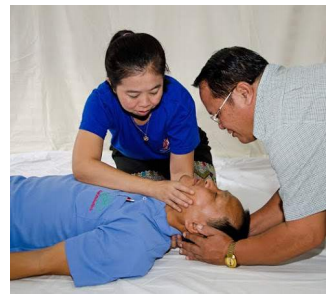
Step 2: Call 3 helpers
Ask 3 helpers to kneel in a row along the victim's body: one kneels near the chest, one kneels near the waist, and one kneels near the knees. They will help move the patient onto the rescue stretcher.
Step 3: Get the life stretcher and other supplies
Ask the 4th helper for a life stretcher or wooden plank; rope, bandages or strips of fabric to secure the casualty to the stretcher and 2 sandbags or cloths to keep the head immobilized.
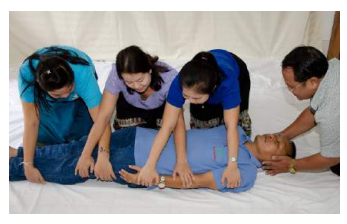
Step 4: Work together BE VERY CAREFUL to transfer the casualty to the rescue stretcher
Primary first aider
Always keep head still. Clear step-by-step instructions for helpers The helper will place his hand over the victim's body so that the hand is along the side opposite to where he or she is kneeling. Helper hands crossed.
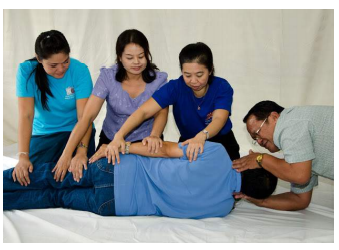
Helper
1 : Place one hand under the victim's shoulder and the other under the waist.
Helper
2 : Place one hand under the victim's ribs and the other on the knee
Helper
3: Place one hand under the victim's thigh and the other at the ankle.
Primary first aider :
Keep head steady. Count one, two, three and ask everyone to pull the victim gently towards them so that the victim leans to one side.
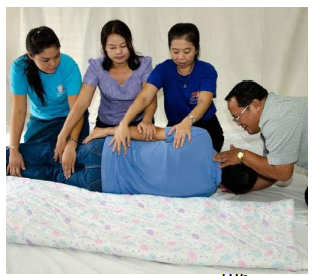
Helper
2: Check the victim's back by palpating from the head down to the spine for abnormalities.
Helper
4: Carefully push the rescue stretcher towards the victim so that it is close to the victim's side of the face.
Primary first aider :
Keep head steady. Count one, two, three and have everyone turn the casualty onto the stretcher. Together, gently push the victim onto the stretcher
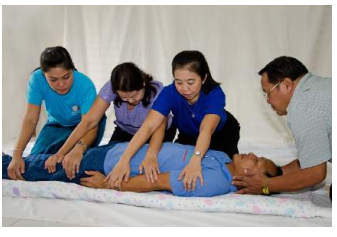
Helpers : Place the forearm along the victim's body
Primary First Aid:
Count one, two, three and ask everyone to use 1 side of their forearm to gently push the casualty into the center of the stretcher . Keep the casualty's head steady and gently move the head while the helper is pushing the victim's body.

Step 5: Fix the casualty to the stretcher
Immobilize the victim's head
Primary first aider: Ask helper
4 to place sandbags or cloth bags on either side of the victim's head. Hold the bags in place until secured with the fabric straps – one on the forehead and one on the chin.
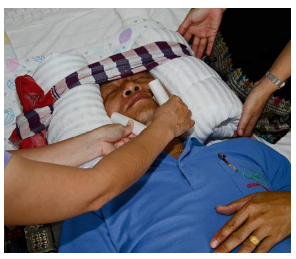
Immobilize the victim's body
Use cloth straps to secure the casualty to the stretcher (tie): one strap at the chest, one at the hip, one at the knee, and one at the ankle. If possible, find a towel or other object to insert between the legs for more stability. Work together to lift the casualty and stretcher carefully. Open airway if victim chokes. If victim is not conscious, follow basic life support steps.

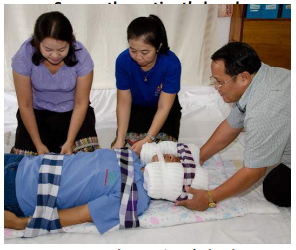
3.4. Assessment Monitor the victim's condition closely, administer first aid, and provide emotional support when necessary.
First aid for head injury or first aid for traumatic brain injury need to be careful and follow the right steps. After performing the first aid steps for a head injury, the first-aider's spine needs to quickly contact the nearest and well-trained medical facilities to safely save the patient's life.
The Emergency Department of Vinmec International General Hospital operates 24/24 on all days of the week, including Saturday and Sunday as well as holidays of the year. The team of emergency doctors and nurses at the Department are professionally and thoroughly trained, able to receive and handle urgent cases of patients, and always coordinate with all specialties in a timely manner. fast.
With modern equipment and a team of experienced doctors, the Emergency Department has conducted emergency and saved the lives of serious and complicated patients. At the same time, patients at the Emergency Department are always coordinated care by many other specialized specialties (Team Base Care). Therefore, at the Emergency Department, patients will be examined, diagnosed, accurately and quickly, with high reliability and intensive treatment right from the emergency stage to help them quickly get out of the critical stage. dramatic and stable.
Để đặt lịch khám tại viện, Quý khách vui lòng bấm số HOTLINE hoặc đặt lịch trực tiếp TẠI ĐÂY. Tải và đặt lịch khám tự động trên ứng dụng MyVinmec để quản lý, theo dõi lịch và đặt hẹn mọi lúc mọi nơi ngay trên ứng dụng.
Bài viết này được viết cho người đọc tại Sài Gòn, Hà Nội, Hồ Chí Minh, Phú Quốc, Nha Trang, Hạ Long, Hải Phòng, Đà Nẵng.






